Durham City Manager Baker Approves of Corrupt Police Procedures, Again
Cooper has said his office will release a written report this week detailing the findings of its investigation, which began in January after Nifong recused himself in the face of a N.C. State Bar disciplinary proceeding.Now that the Attorney General has released his report which strongly condemned the identification procedures, it appears that City Manager Baker has decided against accountability. Holding true to form, the self declared "CEO of Durham" has backed away from responsibility and opted instead to defend the corrupt procedures used to mislead the Grand Jury into indicting innocent men in order to satisfy the demands of Defendant Nifong.
Baker said on Wednesday that officials would study the report and conduct their own post-mortem on the Police Department's investigation.
...
"We need to debrief about our actions in the case, and certainly I look forward to parsing out Police Department actions as opposed to prosecution actions," Baker said. "They can be one in the same or completely separate. And certainly we need to be accountable for any problems we created in this case."
Baker also said he wanted to hear more about Cooper's objections to the disputed lineup, and about "whether or not that type of identification should have been used in the grand jury." (Ray Gronberg, Herald Sun, 4/14/07)
"At the end, I think justice was served," Baker said. "But with the tone of the attorney general's statement, it's incumbent on us to review and debrief on what happened and how we got there. There was a complete, 180-degree swing from 'these three young men are rapists' to 'these three young men did nothing whatsoever.' That's not something that can be dismissed as just how the criminal justice system works. We need to take a long look at that and certainly review our role in the entire process." (Ray Gronberg, Herald Sun, 4/12/07)
On Friday, the News & Observer called called for Durham Police Chief Steve Chalmers to offer a full accounting of his department's participation in the Nifong/Mangum Hoax. Yesterday, City Manager Patrick Baker, as he has throughout the case, answered on behalf of Chief Chalmers and his department. In an interview with the N&O’s Matt Dees, Patrick Baker indicated that a report would be forthcoming. Unfortunately, Baker's comments suggest the report will not be the full accounting demanded, but, instead, a deceptive attempt to justify the failures and complicity of the Durham Police Department in the Hoax rather than an effort to be "accountable for any problems we created in this case."
Friday’s News and Observer editorial:
Obscured in the hubbub following the dropped charges in the Duke lacrosse case has been the disappointing role played by the Durham Police Department. The department's own procedures were swept off the table by a district attorney determined to prosecute what seemed to be a shaky case from the start.Yesterday’s N&O report on Baker’s comments:
Because the alleged incident occurred during a party off campus, in a house rented by members of the team, officers with the Durham police, not Duke University's own police force, investigated after exotic dancer Crystal Gail Mangum claimed she had been raped by three Duke lacrosse players. Early in the investigation the department followed a suggestion by the DA, Mike Nifong, to abandon its photo identification policy.
The policy requires five "filler" photos -- of people not linked with the case -- for each photo of a suspect. Nifong said Mangum should be asked to identify the attackers from 46 photos that included only members of the lacrosse team.
As The N&O's Joseph Neff reported recently in his thorough retrospective on the case, a detective discussed the unusual lineup procedure with his supervisors. Inexcusably, no one objected. The policy also says that an officer unconnected to a case should conduct photo lineups, to avoid the risk of an officer familiar with a suspect influencing which photo is fingered. But Sgt. Mark D. Gottlieb, lead investigator in the Duke case, presented the photos to Mangum.
…
With state Attorney General Roy Cooper deciding that all remaining charges against the three athletes should be dropped (Nifong himself had dismissed charges of rape after first obtaining indictments), the spotlight has been on Nifong's mishandling of the case. But the police department bears some of the blame. Chief Steve Chalmers now should offer an accounting of his department's professional lapses; explain what, if any, discipline has been meted out; and detail what safeguards have been put in place to keep such lapses from occurring again. If Chalmers balks, his bosses, City Manager Patrick Baker and the City Council, should insist.
One flaw in the Duke lacrosse case pointed out by the attorney general's report Friday was that the lineup in which accuser Crystal Gail Mangum identified players as rapists was "of questionable validity." Durham police violated their own policy by not interspersing photos of nonsuspects.Although Baker apparently hopes to dupe the public into believing that "none of the three photo arrays Mangum viewed technically were lineups," the signed instruction form that preceded at least one of the three lineups suggests otherwise. It is titled "Sequential Identification Procedure Verbal Instructions and Certification" and contains the notation "General Order 4077 Attachment 1."
On Friday, City Manager Patrick Baker, who oversees the Police Department, offered an explanation: None of the three photo arrays Mangum viewed technically were lineups.
The photos were intended as much for Mangum to identify witnesses as to identify suspects, Baker said. That doesn't qualify as a lineup, he said.
Baker promised a report next week from Police Chief Steve Chalmers with fuller explanations of that and other issues raised in the Friday report.
The report, Baker said, "will at least explain the basis for why I didn't believe and still don't believe we were conducting a lineup at the time."


In at least two significant ways, each of the three photo identification attempts that Baker pretends were not lineups, violated General Order 4077:
- Policy calls for an independent administrator to run the lineup, not the primary investigator. This avoids any unintentional influence from the investigator.
- The lineup should include five "fillers" -- people who have no connection to the case -- for every suspect, to protect against faulty identification. If an accuser picks a filler photograph, the defense is certain to challenge that witness's reliability. (N&O)
Deficiencies in the Process of Identification of Accused Individuals
As the investigation of the rape allegations went forward, the Durham Police Department in vestigators sought information from the accusing witness to identify her alleged assailants. The special prosecutors concluded that the process by which the accusing witness ultimately identi fied David Evans, Reade Seligmann and Collin Finnerty as her attackers was of questionable validity.The stinging criticism offered by the Nifong/Mangum Hoax Summary of Conclusions echoes the universal condemnation of the no-fail lineup lottery that has come from all commentators not named Mike Nifong, Wendy Murphy, or Patrick Baker.
The first identifying information was provided to authorities on March 14, 2006, the day after the party, when she referred to her attackers as “Adam,” Brett” and “Matt.” In subsequent state ments to the police on March 16, 2006 and April 6, 2006, she described various versions of how the assault occurred, but continued to refer to “Adam,” “Brett” and “Matt” as her assailants.
Two days later, on March 16, 2006, the Durham police showed the accusing witness four dif ferent photo arrays in an attempt to obtain identification evidence. The 24 photographs she was shown included only members of the Duke lacrosse team. After reviewing these photographs the accusing witness was only able to state that she was 70 percent certain that Reade Seligmann was at the party, although she could not recall where she saw him. She was unable to identify any player as one of her attackers.
Eight days after the party, on March 21, 2006, the accusing witness was shown another 12 pho tographs of lacrosse team members. After being shown this array twice, she was again unable to identify any photograph as that of one of her attackers. These 12 photographs included a picture of David Evans, which she also viewed twice and failed to identify.
In late March, 2006, the Durham police obtained Nontestimonial Identification (NTID) orders requiring each white member of the lacrosse team to submit DNA samples and allow photo graphs to be taken. The Durham police, at the direction of the District Attorney, converted these photographs into a PowerPoint presentation.
On April 4, 2006, the accusing witness was shown these new photographs of the players through a PowerPoint presentation. The accusing witness was advised that she would be viewing photos of individuals that the police had reason to believe attended the party.
Each photograph was projected individually, rather than simultaneously in a line-up format. She was shown photographs of only the 46 white lacrosse team members. When shown the photograph of Reade Seligmann, she stated she was 100 percent certain that he had forced her to perform oral sex, but that was all that he did. The photograph of Collin Finnerty was identified with 100 percent certainty as a player who had raped her vaginally and anally. When viewing the photograph of David Evans she identified him with “about 90 percent certainty.” She stated: “He looks like one of the guys who assaulted me . . . He looks just like him without the mustache.” In addition, the accusing witness identified at least one picture of a player from the PowerPoint presentation as being present at the party who further investigation revealed was not there.
The photographic arrays shown to the accusing witness on four different occasions were limited to members of the lacrosse team. “Fillers,” or individuals not regarded as potential suspects, as recommended by Durham Police Department policy for identifying suspects, were never in cluded.
It was not until the April 4, 2006, PowerPoint presentation of 46 team members, without “fill ers,” that the accusing witness first identified the three accused individuals as her attackers.
Almost nine months later, on December 21, 2006, the District Attorney’s chief investigator on the cases arranged a meeting with the accusing witness. Contrary to the practice followed in prior meetings with the accusing witness, the investigator met with her without the presence of another officer to witness and corroborate the questions and answers.
Significantly, the chief investigator also showed her the photographs of lacrosse team members she had previously viewed on April 4, 2006 in the PowerPoint presentation. The chief investiga tor’s interview of the accusing witness was not recorded and neither the chief investigator’s notes nor his subsequent report revealed that the accusing witness was shown the photographs again, although he acknowledged to the special prosecutors in an interview that he had done so.
No explanation for this was contained in the chief investigator’s report or notes. His report does reflect, without explanation, that the accusing witness, for the first time, began referring to the three individuals as David Evans, Reade Seligmann and Collin Finnerty, rather than “Adam,” “Brett” and “Matt.” The chief investigator’s report also does not indicate whether the accusing witness was still able to identify the three individuals previously identified on April 4, 2006.
Showing the accusing witness these photographs which were the subject of a pending motion to suppress, along with her use of the proper names of those charged, provided the defense ad ditional grounds to argue that the out of court and in court identifications should be suppressed, which would effectively have ended the case.
Psychologists Gary Wells and Brian Cutler:
Psychologists Gary Wells and Brian Cutler helped design a procedure in 2003 for witnesses to identify crime suspects. Police departments across North Carolina embraced the procedure. The Durham Police Department adopted it almost word- for-word in February.Duke University Professor of Law James ColemanThe conduct of the Durham police in the Duke lacrosse case, however, is a case study in violating the new policy, the psychologists said. And as a result, police have injected doubt into a woman's selection of three lacrosse players whom she accused of rape.
Police violated two fundamental rules for running an identification procedure, said Wells, a professor at Iowa State University, and Cutler, a professor at UNC-Charlotte.
First, the psychologists said, police did not have an independent investigator administer the process. Second, they neglected to include photos of nonsuspects, known as fillers.
The procedures used can yield only uncertain or misleading results, Wells said, and that's bad for everyone.
If the woman was raped, Wells said, the botched lineups undermine the prosecution and the search for justice.
"And if she wasn't sexually assaulted, or was assaulted by someone else, [the players are] in a position of guilty until proven innocent," Wells said. "It really shifts the burden to the person identified to prove it wasn't them. That is a profoundly difficult and very unfair situation."
...
Cutler, the UNC-Charlotte psychologist, said a witness may identify a suspect for the correct reason: The suspect is the perpetrator.
But, he said, there can be other reasons: The witness could be guessing; the witness could be lying; the witness could be influenced by police behavior to pick a suspect; the witness could be influenced by repeated questioning or by having seen a picture on television or in the newspaper.
"A well-conducted test will maximize the possibility that the reason for identification is recognition and will rule out the other nuisance or extraneous results," Cutler said.
...According to Wells and Cutler, police must give a witness the chance to pick the wrong person. This is why photo lineups contain fillers -- photos of people who resemble the suspects but are demonstrably innocent.
Durham police showed the accuser only photos of Duke lacrosse players, with no fillers. The District Attorney's Office and police had declared all 46 players suspects.
"It's a multiple-choice test with no wrong answers," Wells said.
Wells said he would have urged Durham police to include photos of lacrosse players from other universities.
"You mix them in, and if the witness doesn't know ... or is making it up, she'll pick the fillers," Wells said. "We'd know we have a problem. As it is, I could pick a suspect out of that lineup." (Joseph Neff, News & Observer, 10/08/06)
Coleman said he's followed the case closely in the newspapers but hasn't spoken with any of the lawyers involved. He said he was disturbed by the transcript of the identification procedures, where a police officer told the accuser that she was about to look at photos of everyone who attended the party.
"The officer was telling the witness that all are suspects, and say, in effect, 'Pick three,' " Coleman said. "It's so wrong; it had to be done for a reason other than identification." (Anne Blythe and Joseph Neff, News & Observer, 6/13/06)The condemnation of the Nifong/DPD's corrupt identification procedure within the Attorney General's summary and the comments of Wells, Cutler, and Coleman reflect the results of a Department of Justice study indicating that 85% of wrongful convictions are caused by false eye witness identifications. Their criticism also reflects findings by the Innocence Project, which notes that more than 75% of the exonerations it has achieved were initially cases of wrongful convictions obtained through false identification
60 Minutes asked James Coleman, a prominent law professor at Duke University Law School who helped establish guidelines in North Carolina designed to protect against false identifications in police line-ups. He says this line-up broke one basic principle: there were no “filler” photos, no pictures of people not connected to the case. The accuser only saw photos of lacrosse players who police told her were at the party.
"If she’s told all of these people who were considered suspects were at the party, so you pick three and we’ll indict those three," Coleman says.
"So she can’t make a mistake," Bradley remarks.
"Can’t make a mistake," Coleman replies.
Professor Coleman says the line-up ordered by the D.A. for the Duke lacrosse case violated local, state and federal guidelines. The D.A. has been quoted as saying that will be up to a judge to decide.
Asked why a district attorney would order a line-up that breaks virtually every rule in the book, Coleman says, "Well that's a good question for the D.A. But I assume that, you know after his initial performance, in this case, he needed to indict at least three players. And charge them with what he said was a rape that had occurred." (60 Minutes, CBS, 10/15/2006)
The circumstances under which the alleged victim identified the three defendants is typical. An assumption has been that Nifong and the Durham police merely botched the procedures under which the alleged victim identified the three members of the lacrosse team whom she claims raped her. According to the police account of the identification, however, the police officer who presided over the proceedings told the alleged victim at the outset that he wanted her to look at people the police had reason to believe attended the party. Thus, the police not only failed to include people they knew were not suspects among the photographs shown the woman, they told the witness in effect that there would be no such "fillers" among the photographs she would see.This strongly suggests that the purpose of the identification process was to give the alleged victim an opportunity to pick three members of the lacrosse team who could be charged. Any three students would do; there could be no wrong choice. The prosecutor would not care if the pre-trial identification was subsequently thrown out by the court. The accuser would identify them at trial by pointing to the three defendants seated in front of her as the three men who assaulted her. The prosecutor would argue that she had an independent basis (independent of the identifications thrown out) for doing so. -- James Coleman 6/13/06
Innocence Project:
Eyewitness MisidentificationIn making recommendations similar to those of the Innocence Project, the North Carolina Actual Innocence Commission and the US Department of Justice both suggested that employment of the recommended "best practices" be left to the discretion of local law enforcement agencies.
Eyewitness misidentification is the single greatest cause of wrongful convictions nationwide, playing a role in 75% of convictions overturned through DNA testing.
While eyewitness testimony can be persuasive evidence before a judge or jury, 30 years of strong social science research has proven that eyewitness identification is often unreliable. Research shows that the human mind is not like a tape recorder; it neither records events exactly as it sees them, nor recalls events like a tape recorder that has been rewound. Instead, witness memory is like any other evidence at a crime scene; it must be preserved carefully and retrieved methodically, or it can be contaminated.
When witnesses get it wrong
In case after case, DNA has proven what scientists already know – that eyewitness identification is frequently inaccurate. In the wrongful convictions caused by eyewitness misidentification, the circumstances were different, but witnesses, law enforcement officials and juries all relied on testimony that could have been more accurate if reforms proven by science had been implemented.Mistaken identifications are the leading factor in wrongful convictions
Mistaken eyewitness identifications contributed to over 75% of the more than 194 wrongful convictions in the United States overturned by post-conviction DNA evidence.Traditional eyewitness identification practices – and problems
- Inaccurate eyewitness identifications can confound investigations from the earliest stages. Critical time is lost while police are distracted from the real perpetrator, focusing instead on building the case against an innocent person.
- Despite solid and growing proof of the inaccuracy of traditional eyewitness ID procedures – and the availability of simple measures to reform them - traditional eyewitness identifications remain among the most commonly used and compelling evidence brought against criminal defendants.
How to Improve the Accuracy of eyewitness identifications
- In a standard lineup, the lineup administrator typically knows who the suspect is. Research shows that administrators often provide unintentional cues to the eyewitness about which person to pick from the lineup.
- In a standard lineup, an eyewitness is shown individuals or photographs simultaneously. Research shows that this tends to lead eyewitnesses to choose a lineup member based upon a relative judgment (i.e. who looks most like the perpetrator?), rather than basing the identification on his or her own mental image of the perpetrator.
- In a standard lineup, without instructions from the administrator, the eyewitness often assumes that the perpetrator of the crime is one of those presented in the lineup. This often leads to the selection of a person despite doubts.
The Innocence Project endorses a range of procedural reforms to improve the accuracy of eyewitness identification. These reforms have been recognized by police, prosecutorial and judicial experience, as well as national justice organizations, including the National Institute of Justice and the American Bar Association. The benefits of these reforms are corroborated by over 25 years of peer-reviewed comprehensive research.
1. The “Double-blind” Procedure/ Use of a Blind Administrator: A “double-blind” lineup is one in which neither the administrator nor the eyewitness knows who the suspect is. This prevents the administrator of the lineup from providing inadvertent or intentional verbal or nonverbal cues to influence the eyewitness to pick the suspect.
2. Instructions: “Instructions” are a series of statements issued by the lineup administrator to the eyewitness that deter the eyewitness from feeling compelled to make a selection. They also prevent the eyewitness from looking to the lineup administrator for feedback during the identification procedure. One of the recommended instructions includes the directive that the suspect may or may not be present in the lineup.
3. Composing the Lineup: Suspect photographs should be selected that do not bring unreasonable attention to him. Non-suspect photographs and/or live lineup members (fillers) should be selected based on their resemblance to the description provided by the witness – as opposed to their resemblance to the police suspect. Note, however, that within this requirement, the suspect should not unduly stand out from among the other fillers. (More detailed recommendations can be provided by request by the Innocence Project).
4. Confidence Statements: Immediately following the lineup procedure, the eyewitness should provide a statement, in his own words, that articulates the level of confidence he has in the identification made.
5. The lineup procedure should be documented: Ideally, the lineup procedure should be electronically recorded. If this is impracticable, an audio or written record should be made.
6. Sequential Presentation of Lineups: When combined with a “blind” administrator, presenting lineup members one-by-one (sequentially), rather than all at once (simultaneously) has been proven to significantly increase the accuracy of eyewitness identifications. Specifically, research has shown that witnesses tend to make a “relative judgment” among lineup members when they are presented simultaneously, and thus are more likely to choose an innocent person. Presenting lineup members one-by-one has been proven to reduce the likelihood of witnesses making “relative judgments” and increases overall accuracy of identifications.
North Carolina Actual Innocence Commission
The following recommendations are the results of a study conducted by the North Carolina Actual Innocence Commission. Information used by the Commission in reaching its recommendations included the U.S. Department of Justice research report, Eyewitness Evidence, A Guide for Law Enforcement (October 1999); the New Jersey Division of Criminal Justice training manual, Attorney General Guidelines for Preparing and Conducting Photo and Live Lineup Identification Procedures (August 2001); a survey and study of the identification procedures currently followed by North Carolina’s law enforcement; and presentations and consultations by experts Professor Gary Wells, Distinguished Professor of Psychology at Iowa State University and expert on eyewitness memory; Professor Brian Cutler, Chair of the Department of Psychology at UNC Charlotte and expert on eyewitness memory; and New Jersey Deputy Attorney General, Lori Linskey, who was responsible for the statewide implementation of revised identification procedures in that state. The recommendations cover the most important aspects of “best practices” in witness identification procedures; however, they leave the details of implementation of these practices to the discretion of law enforcement.
The recommendations made herein are not intended to create, do not create, and may not be relied on to create, any rights, substantive or procedural, enforceable at law by any party in any matter civil or criminal. Jurisdictional or logistical conditions may preclude the use of particular procedures.
In developing its eyewitness evidence procedures, every jurisdiction should give careful consideration to the recommendations in this Guide and to its own unique local conditions and logistical circumstances. Although factors that vary among investigations, including the nature and quality of other evidence and whether a witness is also a victim of the crime, may call for different approaches or even preclude the use of certain procedures described in the Guide, consideration of the Guide’s recommendations may be invaluable to a jurisdiction shaping its own protocols. As such, Eyewitness Evidence: A Guide for Law Enforcement is an important tool for refining investigative practices dealing with this evidence as we continue our search for truth.By offering his approval of the corrupted process that led to the indictment of factually innocent men, Durham City Manager Patrick Baker demonstrated his willingness to cover up the corrupt procedures. His shameful decision to endorse the procedures that are universally denounced also demonstrates clearly the need for the North Carolina legislature to ignore the suggestions of the NCAIC and DOJ, by disallowing local jurisdictions to selectively install and follow "best practices." The Eyewitness Identification Reform Act proposes making the actions Baker endorses a criminal act.
Eyewitness Identification Reform Act
A bill was filed in the state Legislature Thursday that could change the way police conduct photo line-ups. It’s a bill that could have helped in the Duke lacrosse case.
When Durham police asked accuser Crystal Mangum to identify her attackers, they only showed her pictures of 46 Duke Lacrosse players. The person who conducted the line-up was also involved in the investigation.
A bill filed in the General Assembly would make both of those acts illegal.
“It'll make sure innocent people are not put through the trauma of an unfair process,” said Rep. Deborah Ross, (D) Wake County. “It'll also lead us to the guilty more quickly.”
...
Those requirements have investigators use filler photos of people not associated with the crime. They also eliminate anyone working on the investigation from being involved.
...
If an agency didn't comply, this bill wouldn't make it a criminal offense. It mainly acts as a deterrent to officers. (WRAL 4/19/2006)
As incredible as Baker's attempt to affirm the unethical identification procedures may appear, his aversion to accountability, willingness to deceive, and acceptance of improper procedure should come as no surprise. Throughout the Nifong/Mangum Hoax, Baker has proven himself a willing enabler of the misdeeds of his police department and the rogue prosecutor. Outside the Hoax, Baker has demonstrated an equal willingness to compromise procedure and truth.
Crystal Mangum Never Changed Her Story
"Baker said he has never received any indication that the woman said she was raped by 20 men or that she changed her story.Durham Police Conducted an Actual Investigation
"I have no idea where that came from," Baker said. "I've had a lot of conversations with the investigators in this case and with officials at Duke, and at no time did anyone indicate the accuser changed her story. If that were true, I'm sure someone would have mentioned it to me."
Baker, who spoke with police officials Tuesday about the chain of events, bristled at the implication that city officers did not believe the accuser. He said that the incident was classified as a sexual assault about 30 minutes after the woman arrived at the hospital and that investigators were quickly put on the case.
"Any assertion that the Durham Police Department didn't take this case seriously or indicated that it would blow over is completely contradicted by the facts and our actions," Baker said. (N&O)
“Baker said he will be interested to see what new details the show brings to light, but he doesn't believe the Durham Police Department's work on the case should be second-guessed if new statements contradict previous ones.”
"If the dancer says one thing to our officers and another to '60 Minutes,' it raises questions about her credibility and the credibility of the entire case," Baker said. "The Police Department is at the whim of the evidence given to them. ... If people have given the Durham Police Department the wrong information, it's certainly going to affect the DA's ability to prosecute the case."
“But, he cautioned, "Keep in mind these men were indicted by a grand jury. ... It wouldn't be the first time an indictment has occurred based on information that is later proven to be false. I think justice needs to be served. I don't want anyone to go through indictments when they're innocent. If the witness or the victim is not telling the truth, that's going to come out." (Herald Sun)
"The Durham Police Department has responded quickly and adequately under the circumstances." (CNN)
In affidavits, the police said there was medical evidence of rape and sodomy. Patrick W. Baker, the Durham city manager, told the City Council on Thursday that the police were continuing to collect evidence. (NY Times)
It took two days before police searched the house where a woman said she was raped by Duke University lacrosse players because 31 hours passed before she was able to provide details about what happened, the city manager says. The woman reported within an hour that she had been raped at a March 13 lacrosse team party, according to police. But she couldn't provide a lengthy interview until later, City Manager Patrick Baker said. He told the Durham City Council Thursday that emotional and physical trauma can often delay a witness's ability to tell police what happened. "The basic rule of thumb is that we work at the complaining witness's timetable," he said. (TL)
"But, when it comes to allegations of sexual assaults, we -- the -- the basic rule of thumb is that we work at the -- the complaining witness' timetable." (CNN)
Baker, who oversees the police department, said the visits at dormitories were similar to a "knock and talk," in which officers chat up residents about a crime. Players' attorneys objected to detectives' questioning of players without the lawyers' permission.Don't Drink the Water
Baker said that because the students were not indicted and Duke police knew of the visit, authorities were not violating anyone's rights.
"There were three individual lacrosse players we talked to, and they politely refused to talk to us," Baker said. "That's within their rights, and we moved on."
On Friday, Baker repeated assertions that the failure to disclose the unflattering data resulted from a misunderstanding of the rules, as well as from a series of honest mistakes. He also said state officials had not clearly laid out what test results the city was required to disclose.Your Pants and Your Dump are on Fire
"I've been concerned whether this is a protocol issue or a public health issue, and I feel it is a protocol issue," the city manager said. "If we were gaming the system or trying to hide something and we had all of this information, I don't know why we wouldn't have just gotten rid of it. ... I drink the water. My kids drink the water. I want to know if the water is safe and what can be done to make it safer."
"We're going to follow the letter of the law," Baker said. "Since we have been accused of not following the letter of the law, we'll do what [state officials] ask us to do."
"This has been a very difficult time for the community and for the administration," Baker said at a City Council meeting. "I certainly personally regret that this incident occurred and that many of our citizens were affected by the yard waste fire. This has been a lesson. I hate to make mistakes like this. I hate for this organization to make mistakes like this. We are putting measures in place to make sure the events that happened ... don't happen again."Most dangerously, Patrick Baker’s inane word games and public approval of the purposefully corrupted procedures utilized in the Hoax risk setting a precedent that invites the Durham Police Department to ignore set procedures in the future. By adopting Defendant Nifong’s transparently self-serving argument that a lineup is not a lineup, Baker subjects Durham citizens to a law enforcement setting which can freely disregard proper procedures, ignore the basis for pending legislation designed to make employment of similar procedures a criminal act, and dismiss studies by the Innocence Project, the North Carolina Actual Innocence Commission, the Department of Justice, and the nation's most respected academics in the field.
In the Nifong/Mangum Hoax, a demonstrably unstable false accuser was encouraged by Durham police to randomly identify three innocent young men for a crime that the independent investigation by the NC Attorney General’s Office proved never occurred. Acting as willing accomplices of a politically motivated prosecutor determined to seek fraudulent indictments vital to his election campaign, Durham police then presented those “identifications” to a grand jury in order to gain indictments of factually innocent men. An ethical city manager would investigate and publicly explain the departmental failures that resulted in the Durham PD docilely complying with the malicious whims of a rogue prosecutor willing to sell his soul to win an election. For Baker, it appears that absolving the Durham Police Department of responsibility outweighs ensuring that similar injustice is avoided in Durham.






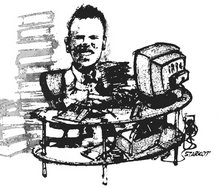
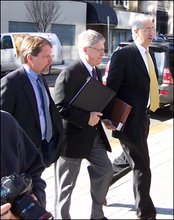
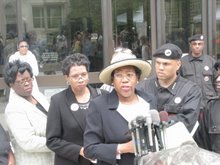
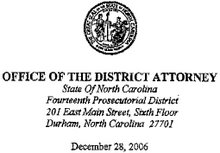






















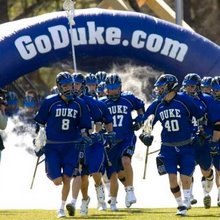

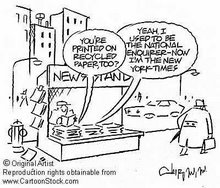

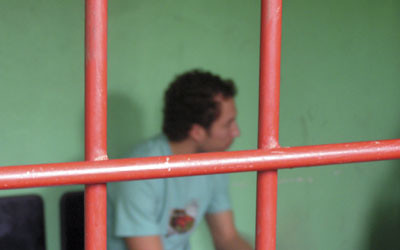
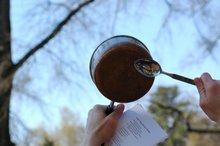

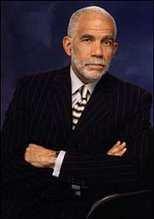







17 comments:
This is one terrific post. I plan to link to it and send links to Durham Mayor Bill Bell and every member of the Durham City Council.
The information and commentary you provide is the kind of public information and service we used to find in quality newspapers.
My hat is off to whoever put this post together.
John in Carolina
When I read this, I become even more angry. From Baker and Chalmers all the way down the line, all we got were lies. This is obstruction of justice, and some people need to pay with their freedom.
I can only hope that the U.S. Department of Justice does what it is supposed to do in a situation like this. These people from day one did not care WHO Crystal chose, just as long as she chose SOMEBODY. Criminal charges are needed, and needed soon.
great Analysis - what to do - Unless the Feds come in and clean this mess up - nothing. Getting the criminal case resolved in favor of the boys was a major achievement. I will stay out of North Carolina.
Carolyn says:
Awesome analysis. Simply awesome.
But depressing. I swore if I heard someone say 'Frankly, my dear, I don't give a damn about justice' one more time, I would scream.
Damn, I'm screaming.
CLEAR OBSTRUCTION OF JUSTICE!!! Why would anyone in Durham, or in any civilized community tolerate this from their police force? I'd be mad as hell if I lived in the police state that passes for North Carolina. Incredible. Is no one angry? Is no one embarassed? Does anyone in Durham understand the implications of this on their basic freedoms? Do they care???
One of the best posts and it was sorely needed. The Durham Leadership is as dirty as they come.
This sentence from your post is most apropos:
"Baker’s comments give the impression that the purpose of the report is not to professionally account, but to intentionally distort."
Indeed!
They've had to clean up Louisiana, they've had to clean up my beloved Alabama, and now it's time for the DOJ to clean up North Carolina. I only hope that Attorney General Gonzales' legal woes don't delay the reforms and criminal prosecutions of high-ranking officials in Durham that are so desperately needed. It is painfully obvious that Baker, Nifong, and a good portion of the DPD, including most of their top leadership, are a clear and present danger to the people of Durham, NC.
Liestoppers Team,
This is an award winning piece of journalism. I am constantly amazed by your teams absolute ability to ferret out the facts.
I appreciate and acknowledge KC's great works but you have consistently, and most times without the thanks you deserve, gone far deeper into the truths of this case.
It is remains clear you are, and always have been, about justice and not about selling a book.
Bravo!
Somebody has his hand in the Cookie Jar!
Could that be a Baker's Dozen?
8:27 said --
"Why would anyone in Durham, or in any civilized community tolerate this from their police force?"
People in civilized communities do not tolerate this from their police force. Durham is not a civilized community.
I live in the police state of North Carolina, but far away from the political and moral cesspools of Raleigh and Durham. Never been there; never will.
As I read this post, I kept saying to myself, "What great information! And there's even more!"
The information on faulty eyewitness indentification was especially good; it really explains WHY the "photo array" provided to Mangum was such an affront to justice.
Keep up the good work.
I'm confident Baker's investigation of the Hoax with be as thorough and open to public review as were the Blinco's results.
Darby.......
I do not understand why no one--other than myself--noted that Baker, in answer to Duke's claim that it failed to show immediate concern because DPD said the witness was unreliable, actually threatened local police. He said he would talk to each officer involved to make sure they were all "on the same page." When questioned about whether this was appropriate, Baker pointed out that he was their actual employer & made it clear that an "employee" who questioned the validity of the investigation or the victim would find his/her job at risk.
Seems CGM used names "Brett, Matt,
Adam," that she thought were
likely to be "white," just as if
a person was (falsely) accusing
an AA, and used "DeShawn" or
"Marcus" or whatever.
It's a form of racism, just
as calling an Hispanic "Julio"
or a Chinese person "Wong"
or a...you get the picture.
It should have sent red flags
up all over the place that this
woman just wanted to pick a
couple of victims to sue at a
later date - any name'll do!
please, can someone clear up one mystery for me.
at the april 4th lineup where crystal falsely accused reade, collin and david, she also accused matthew wilson of participating in the assault. for some reason there were no follow-up questions by the investigator about matthew and he was never falsely indicted for rape/assault.
considering the fact that four players were identified, why were only reade, david and collin indicted? this is especially difficult to fathom considering the rock solid alibis two of them had. why those three and why no follow-up on matthew?
{The Roots Of Evil}
I am still praying the citizens, and world will not forget the numerous issues that plague Durham. My best friend and only brother, Allen Jackson Croft Jr. was murdered there May 11, 2005.
The Sheriff's Department have lied to us, threatened me, and have refused to comply by any means of due process ther is!
His death has not only been unresolved but also vehemently ignored! What media attention there is has been given solely on the LAX3 Hoax.
Meanwhile murders, kidnapping, massive drug trafficking, human slavery for prostitution, and God knows what else continues status quo, by "Elected Officials, Law Enforcement, And Our court system!"
Yet meanwhile "The Emporer Has No Clothes."
Not to mention the massive corruption in almost every arena, and these are truely crimes against humanity and there should be accountability!
I STILL am waiting for reports, documents, and evidence the family should be privy to! Imagine this being your only child, brother, best friend, or even a complete stranger for that matter!
J-U-S-T-I-C-E
Webster's describes justice as being:
Quality of being just; rectitude; propriety; impartiality; fairness; just treatment; merited reward or punishment; a judge holding a special office.
And then there is R-I-G-H-T-S
Webster's again describes it as such:
Straight; upright; just; suitable; proper; real; correct; belonging to that side of the body farther from the heart; to be worn outward; perpendicular; formed by one line perpendicular to another; Justly; correctly; very; directly; to the right hand; What is right; rectitude; a just claim; authority; side opposite to the left; To put right; to do justice to; to restore to an upright position; To assume a vertical position.
To may family and many others these words seem invisible, our pleas MUST be heard!
When the entire Hoax is over, I pray I may find the platform to turn this atrocity into goodness, and bring some order amid the rampant chaos!
Remember,
"United We Stand, Divided We Fall!"
God Bless America, Or Troops, World, Loved Ones, And One Another This Memorial Day, And Every Day!
Respectfully,
Rhonda Fleming
Cleveland, Ohio
PS, ooopsie on my typos, I was unable to edit.
My kittens keep jumping all over the keyboard, and they are just to adorable to be mad at, LoL!
Again, God Bless,
Rhonda Fleming
Post a Comment